 How To Draw Animals A brief guideby Michael Terry Michael Terry Copyright 2011 All Rights Reserved
How To Draw Animals A brief guideby Michael Terry Michael Terry Copyright 2011 All Rights Reserved 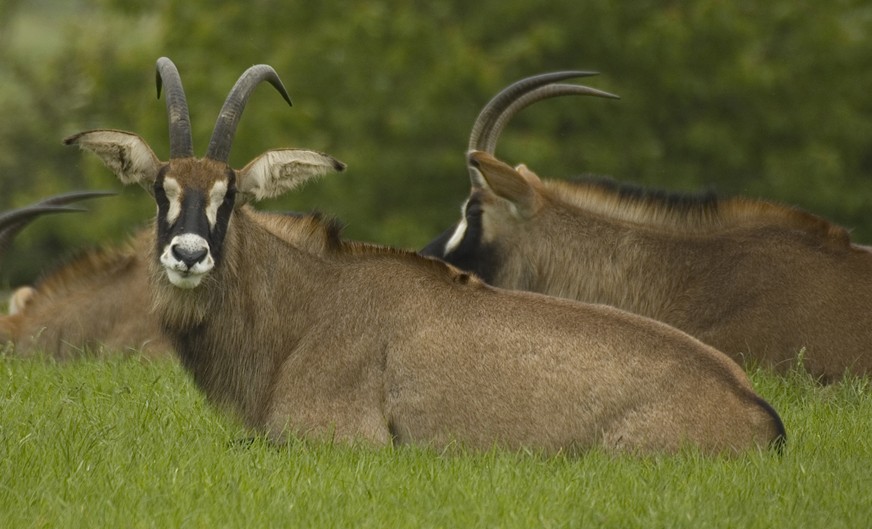 Welcome to www.performingpencil.comthe site dedicated to drawing.So lets get going on how to draw Animals. Animals are very rewarding to draw, there is such variety in shape and size from a tiny mouse to a magnificent African Elephant. Can you think of any other group of creatures that has such contrast. There is so much to draw here so much to observe and capture. For the most part being able to draw something is down to careful observation, take time to study what you wish to draw. Look at it's proportions, how big is one part to another, find a part of it that you can compare to the rest treat it like a ruler. Also look for how things relate to each other.
Welcome to www.performingpencil.comthe site dedicated to drawing.So lets get going on how to draw Animals. Animals are very rewarding to draw, there is such variety in shape and size from a tiny mouse to a magnificent African Elephant. Can you think of any other group of creatures that has such contrast. There is so much to draw here so much to observe and capture. For the most part being able to draw something is down to careful observation, take time to study what you wish to draw. Look at it's proportions, how big is one part to another, find a part of it that you can compare to the rest treat it like a ruler. Also look for how things relate to each other.
But before you start first chose a soft drawing pencil like a 4B or8B and get a soft putty eraser rather than a conventional eraser and a good quality drawing pad, these will help in achieving the results you are after. For drawing animals why not draw your cat or dog. Or go to a park and sketch the squirrels there and if your lucky the dear. Also a wildlife park if you have one nearby is excellent for animals to draw. What I am going to show you now is how to start and work through to a finished drawing. 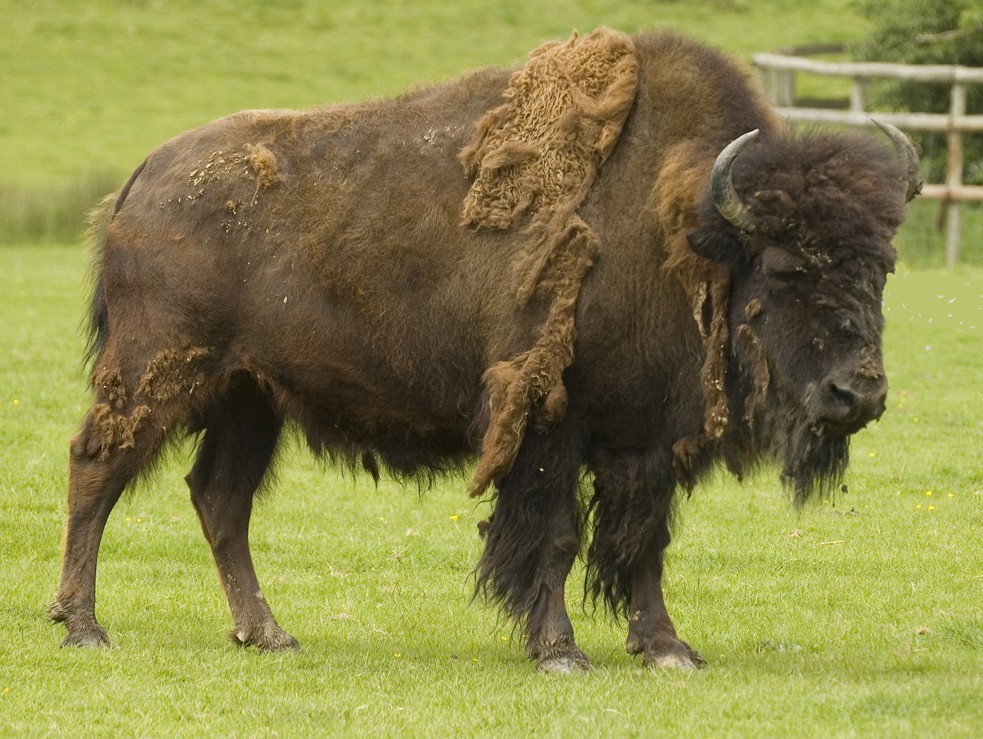 Getting started. Start by getting the overall shape of the body, neck and head, the head being the smallest part it can be used as a measure for the rest.
Getting started. Start by getting the overall shape of the body, neck and head, the head being the smallest part it can be used as a measure for the rest.
Here I would like to mention a very useful tool for getting proportions right, its called the 'Proportion Measure' and is included within the full eBook. To continue make sure you sketch lightly as you will want to remove any unwanted lines later. Next start to sketch in the legs and as mentioned above use the head as a measure , once you are satisfied that all these are in proportion you can start defining the animals shape. Next you can start on the detail but before you do so you can erase any unwanted lines, other wise it will be difficult once all the details are in place. Now you can render in some shading, this will give it a more three dimensional appearance also you can put in any markings.  The first example is of a squirrel.Stage One The first stage is to get the overall body shape, once you are happy with this then you can move to the next.
The first example is of a squirrel.Stage One The first stage is to get the overall body shape, once you are happy with this then you can move to the next. 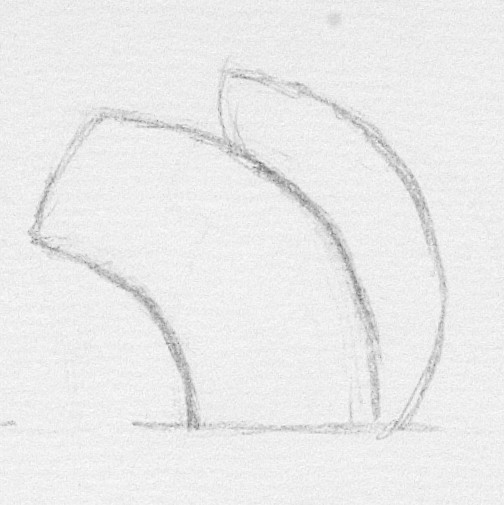 Stage Two I have now added the basic shape of the tail.
Stage Two I have now added the basic shape of the tail. 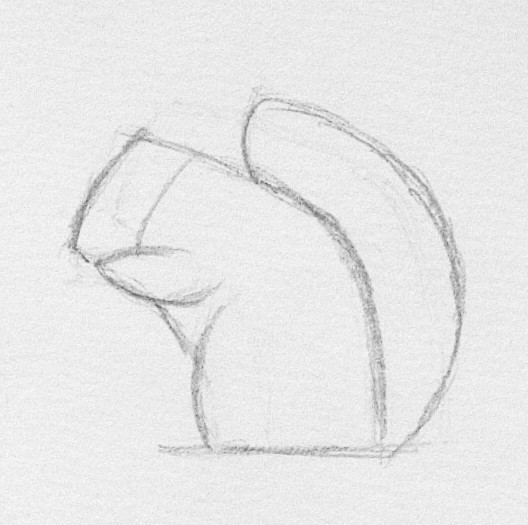 Stage Three Now I have added the beginning of the rear leg, the forearm and indicated the position of the head.
Stage Three Now I have added the beginning of the rear leg, the forearm and indicated the position of the head.  Stage Three Now I have added the beginning of the rear leg, the forearm and indicated the position of the head.
Stage Three Now I have added the beginning of the rear leg, the forearm and indicated the position of the head.
The depth of the rear leg is about the same as the thickness of the top of the body and the length of the forearm is the thickness of the tail. Measuring one shape against another will help you get shapes the right size. 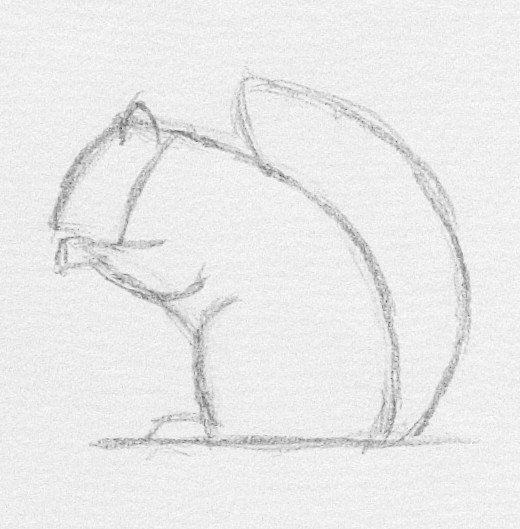 Stage Four Here I have added an ear, hand and foot.
Stage Four Here I have added an ear, hand and foot. 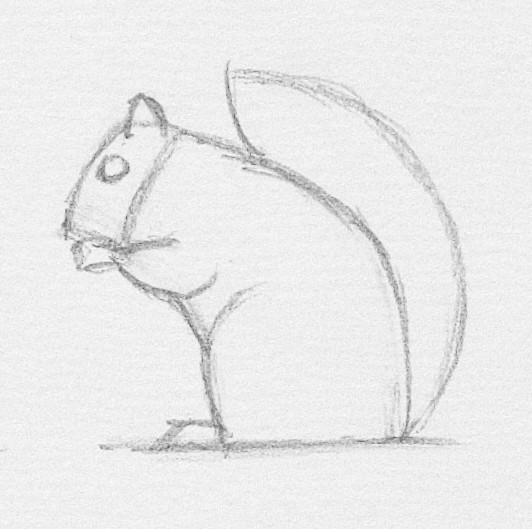 Stage Five Just added the eye.
Stage Five Just added the eye. 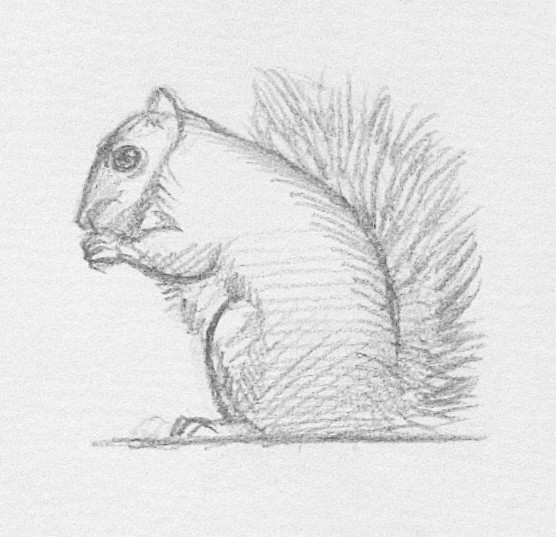 Stage Six This is my final stage, I have lightly rubbed out the pencil lines so that I can put in the detail like the hairs of the tail.
Stage Six This is my final stage, I have lightly rubbed out the pencil lines so that I can put in the detail like the hairs of the tail. 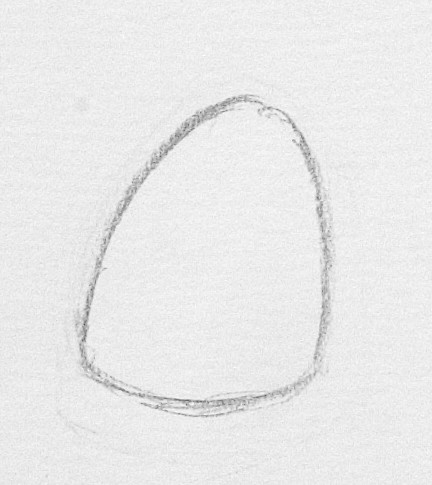 Now I shall draw a rabbit to reinforce theprinciples.Stage One Here like the first example I have drawn the basic body shape.
Now I shall draw a rabbit to reinforce theprinciples.Stage One Here like the first example I have drawn the basic body shape. 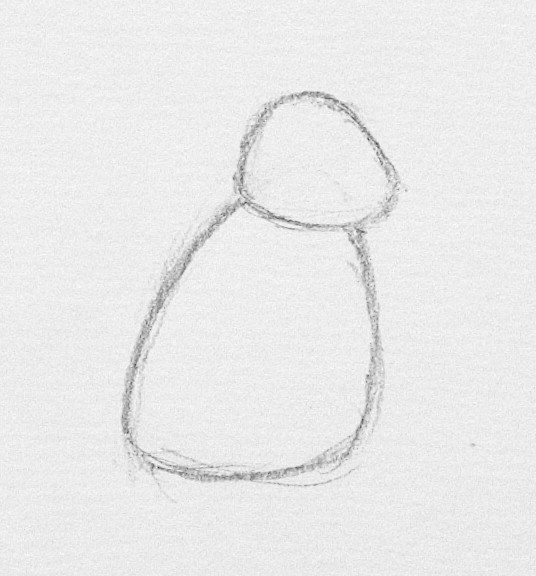 Stage Two Now I have added the head shape.
Stage Two Now I have added the head shape.  Stage Two Now I have added the head shape.
Stage Two Now I have added the head shape.
Here you can now use the head as a measure, in this instance from the top of the head to the bottom goes two times in the hight of the body. 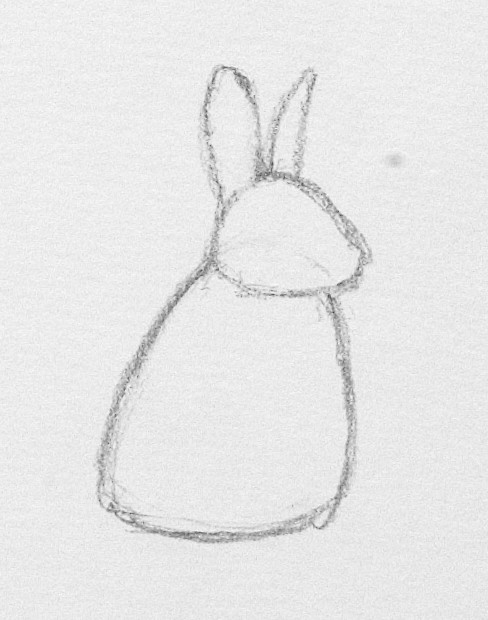 Stage Three Next I have added the ears, the hight of the ears is roughly the same as the depth of the head.
Stage Three Next I have added the ears, the hight of the ears is roughly the same as the depth of the head. 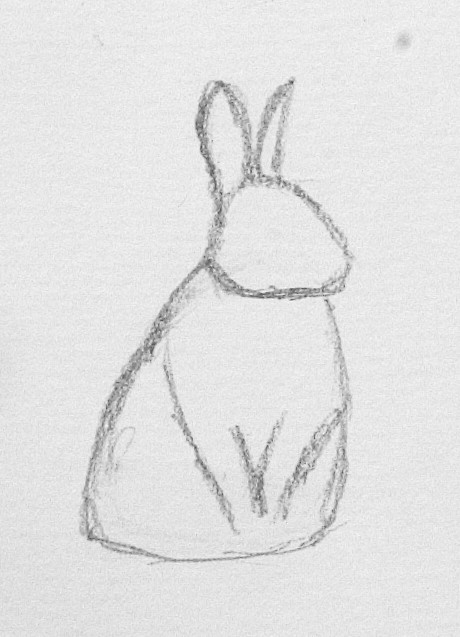 Stage Four Arms have now been added, these are roughly the same in length as the depth of the head.
Stage Four Arms have now been added, these are roughly the same in length as the depth of the head. 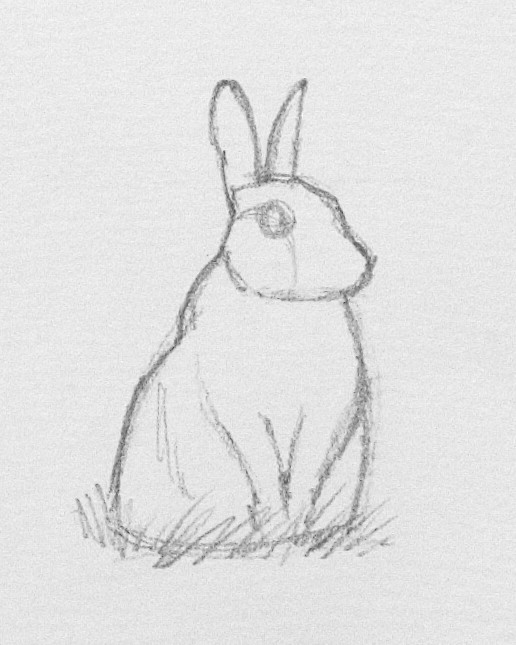 Stage Five Here I have now began to add shape the basic shapes and the eye. Also some grass.
Stage Five Here I have now began to add shape the basic shapes and the eye. Also some grass. 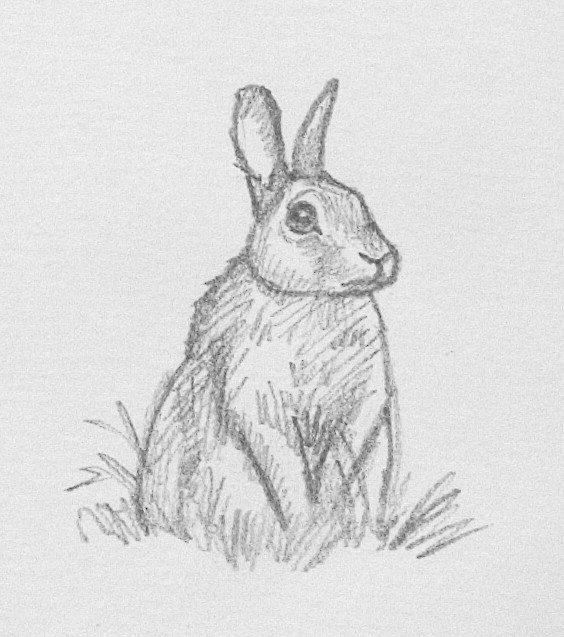 Stage Six Here is the final drawing, I have added more detail like the nose and mouth also shading to help to show form plus more detail in the grass.
Stage Six Here is the final drawing, I have added more detail like the nose and mouth also shading to help to show form plus more detail in the grass.
One thing to remember, this is just a sketch not a finished piece that is going into the Royal Academy Summer Exhibition! Just relax it doesn't mater if you make mistakes, just learn from them and enjoy your self! Don't forget just relax and enjoy drawing, its a big adventure with a great ending! Further Help. I hope you have enjoyed this eBook sample and have found it helpful in developing your drawing skills, if so then why not get hold of the complete book which is full of helpful advise on drawing. What I have given you in this sample is only a basic guide, there is a lot more in the full eBook which will help you to produce a drawing you will be happy with. Below are the subjects covered within the book. As I said at the beginning I have also included an invaluable tool that will go a long way in helping you to achieve the results you are looking for in your drawings. I have called this tool the 'ProportionMeasure' and I think you will find this indispensable. The eBook 'How to Draw Animals' has a great deal more within it to help you draw better.
Here are the subjects covered. Familiarizing yourself with the subject.
Next page

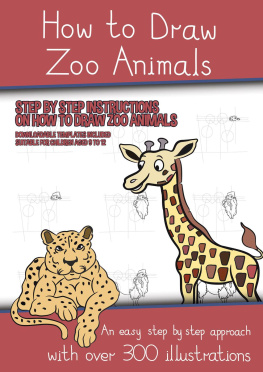


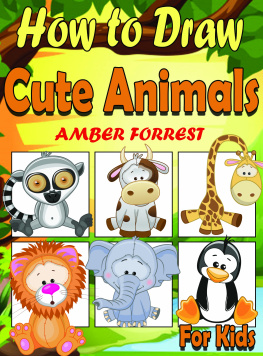
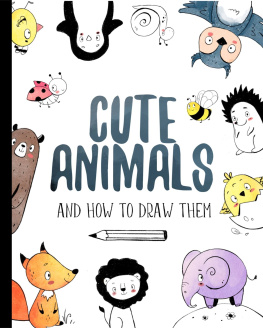
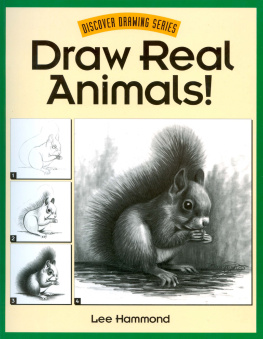
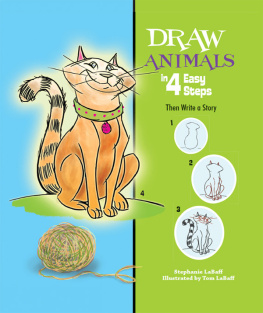
 How To Draw Animals A brief guideby Michael Terry Michael Terry Copyright 2011 All Rights Reserved
How To Draw Animals A brief guideby Michael Terry Michael Terry Copyright 2011 All Rights Reserved  Welcome to www.performingpencil.comthe site dedicated to drawing.So lets get going on how to draw Animals. Animals are very rewarding to draw, there is such variety in shape and size from a tiny mouse to a magnificent African Elephant. Can you think of any other group of creatures that has such contrast. There is so much to draw here so much to observe and capture. For the most part being able to draw something is down to careful observation, take time to study what you wish to draw. Look at it's proportions, how big is one part to another, find a part of it that you can compare to the rest treat it like a ruler. Also look for how things relate to each other.
Welcome to www.performingpencil.comthe site dedicated to drawing.So lets get going on how to draw Animals. Animals are very rewarding to draw, there is such variety in shape and size from a tiny mouse to a magnificent African Elephant. Can you think of any other group of creatures that has such contrast. There is so much to draw here so much to observe and capture. For the most part being able to draw something is down to careful observation, take time to study what you wish to draw. Look at it's proportions, how big is one part to another, find a part of it that you can compare to the rest treat it like a ruler. Also look for how things relate to each other. Getting started. Start by getting the overall shape of the body, neck and head, the head being the smallest part it can be used as a measure for the rest.
Getting started. Start by getting the overall shape of the body, neck and head, the head being the smallest part it can be used as a measure for the rest. The first example is of a squirrel.Stage One The first stage is to get the overall body shape, once you are happy with this then you can move to the next.
The first example is of a squirrel.Stage One The first stage is to get the overall body shape, once you are happy with this then you can move to the next.  Stage Two I have now added the basic shape of the tail.
Stage Two I have now added the basic shape of the tail.  Stage Three Now I have added the beginning of the rear leg, the forearm and indicated the position of the head.
Stage Three Now I have added the beginning of the rear leg, the forearm and indicated the position of the head.  Stage Four Here I have added an ear, hand and foot.
Stage Four Here I have added an ear, hand and foot.  Stage Five Just added the eye.
Stage Five Just added the eye.  Stage Six This is my final stage, I have lightly rubbed out the pencil lines so that I can put in the detail like the hairs of the tail.
Stage Six This is my final stage, I have lightly rubbed out the pencil lines so that I can put in the detail like the hairs of the tail.  Now I shall draw a rabbit to reinforce theprinciples.Stage One Here like the first example I have drawn the basic body shape.
Now I shall draw a rabbit to reinforce theprinciples.Stage One Here like the first example I have drawn the basic body shape.  Stage Two Now I have added the head shape.
Stage Two Now I have added the head shape.  Stage Three Next I have added the ears, the hight of the ears is roughly the same as the depth of the head.
Stage Three Next I have added the ears, the hight of the ears is roughly the same as the depth of the head.  Stage Four Arms have now been added, these are roughly the same in length as the depth of the head.
Stage Four Arms have now been added, these are roughly the same in length as the depth of the head.  Stage Five Here I have now began to add shape the basic shapes and the eye. Also some grass.
Stage Five Here I have now began to add shape the basic shapes and the eye. Also some grass.  Stage Six Here is the final drawing, I have added more detail like the nose and mouth also shading to help to show form plus more detail in the grass.
Stage Six Here is the final drawing, I have added more detail like the nose and mouth also shading to help to show form plus more detail in the grass.